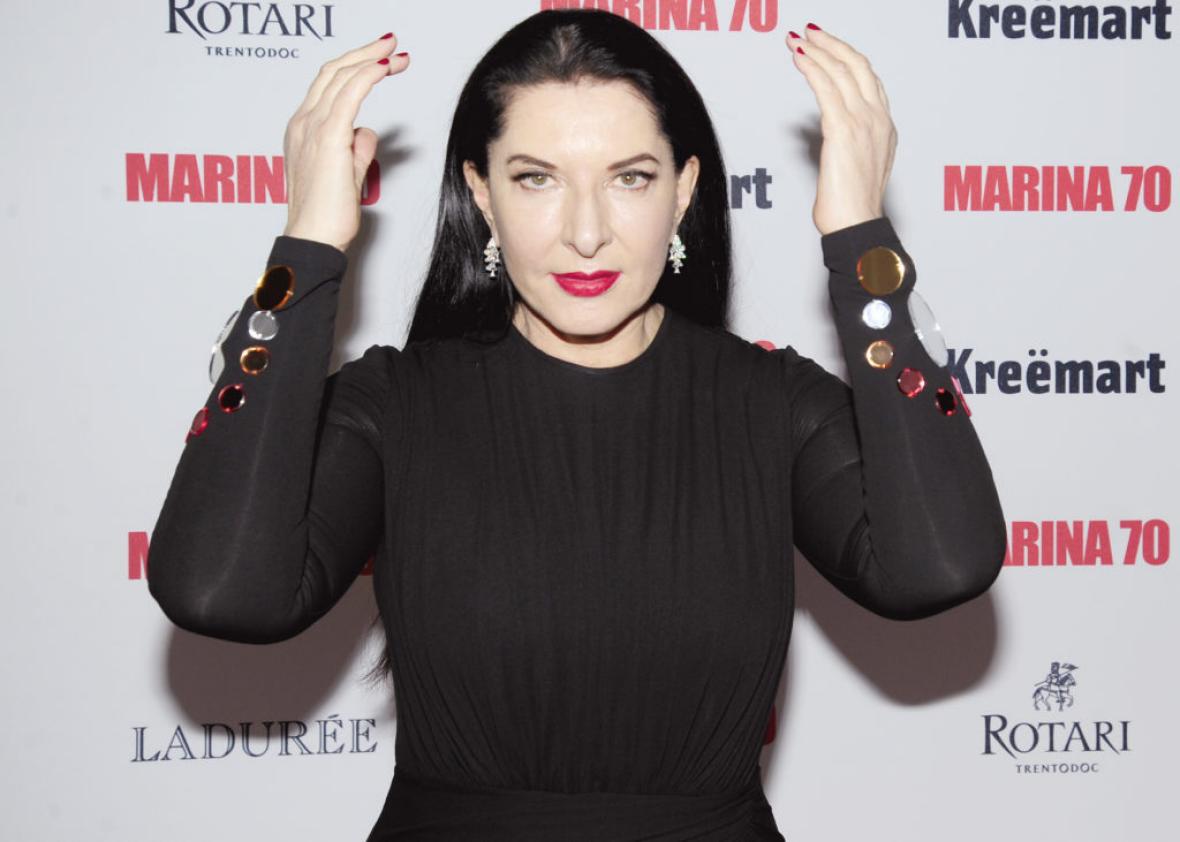Last Thursday night, performance artist Marina Abramovic celebrated her 70th birthday and the release of her memoir, Walk Through Walls, at the Guggenheim Museum in New York. A press release claimed that attendees included “close friends and supporters” along with members of the “arts and entertainment” community more broadly. Other guests: Bella Hadid, Naomi Campbell, and, according to someone overheard by a woman who stood behind me at the event, Monica Lewinsky. Abramovic’s memoir has received mixed reviews. Book critic Dwight Garner called it “shallow and misconceived” and novelist Francine Prose called it “engrossing” in two separate assessments in the New York Times.* The party, too, veered between the ridiculous and the sublime.
Upon entering the museum, guests were given cards with instructions and pairs of noise-canceling headphones. The card explained that the event would be divided into two sections. The first, labeled “Silence,” was to last 70 minutes, one for each year of Abramovic’s life to date. During this silence, we would be “served a glass of water.” Then we would experience “entertainment.” Two screens on either side of the rotunda welcomed the artist’s “friends and enemies” to the party.
“Silence” demanded that we put on our noise-canceling headphones and “refrain from verbal communication.” The screens explained that this exercise would “help you concentrate on your heartbeat and your self.” (Why did I need to concentrate on my heartbeat? Was there something wrong with my heartbeat? I once had palpitations, but that was because I drank too much tea in an airport.) For the allotted time, most attendees milled about the space, glancing furtively at each other to determine how it’s supposed to look when you are concentrating on yourself. Others examined the stage—piano, gong, microphone—and the lounge chairs arranged before it. Some greeted each other verbally, in flagrant violation of the precepts, or tuned out their heartbeats just long enough to pose for the event photographers.
“Facilitators in white lab coats”—art students who told me they found the gig through Craigslist and similar services—were stationed about the atrium, applying swatches of gold leaf to participants’ mouths. (One of the facilitators told me, after “Entertainment,” that the alien process brought out people’s “innocence.”) The decoration was meant to recall both Orthodox Christian icons and the Ayurvedic practice of feeding gold and honey to infants. It was messy and got in the men’s beards and made everyone look like they had just swallowed a Klimt.
After 70 minutes, Abramovic swept down the Guggenheim’s spiral, alongside a guy in a suit and a figure in a black hooded cloak, and rang the gong: the hour of “Entertainment” had arrived. The guy in the suit sat down at the piano. Abramovic read a disconcertingly normal birthday speech. It sounded, as one attendee put it, like “anyone in suburban New Jersey” could have given it. Unlike a suburban New Jerseyite, Abramovic read the speech from a scroll. She said that her friends and enemies had made her stronger, that she intended to stick around for a while, and that (in her Balkan diction) “unhappiness is waste of time.” (This will come as a relief to those of us who had blocked out the next few years for unhappiness.) She read the last paragraph of her memoir from the scroll and theatrically dropped it into the crowd. Then—and this struck me as deliriously funny—the pianist began to play and the hooded person began to sing. It was Anohni, of Antony and the Johnsons, singing “My Way,” Frank Sinatra’s 1969 hit and a favorite at British funerals.
Abramovic’s art is about the limits of human endurance, not semiotic subtlety, and the choice of music bore that out. “I’ve lived a life that’s full, I’ve traveled each and every highway, but more, much more than this,” sang Anohni, “I did it my way.” Having willfully stabbed herself, jumped into bonfires, and invited museum audiences to whip, beat, and shoot her, Abramovic probably has a better claim to these lyrics than Sinatra. She did it her way, as nobody in their right mind would.
As Anohni sang the hammiest song in the world, Abramovic gazed reverently toward the heavens, placed her hands over her heart, closed her eyes, and lowered her head. She rang the gong again and invited people to schmooze. I climbed up to the first tier of the spiral. From there, I could see David Copperfield, up-and-coming British artist Daniel Lismore in a jeweled robe, and Abramovic, her arms full of gifts, warmly embracing everyone in sight. It didn’t seem to be an act.
*Correction, December 12, 2016: An earlier version of this piece misidentified the author of the negative New York Times review of Abramovic’s memoir. It was Dwight Garner, not Holland Cotter.
